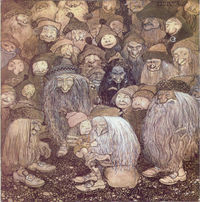
Hobbits Found!
Scientists have determined that the first skeleton they found belongs to a species of human completely new to science. Named Homo floresiensis, after the island on which it was found, the tiny human has also been dubbed by dig workers as the "hobbit," after the tiny creatures from the Lord of the Rings books.The original skeleton, a female, stood at just 1 meter (3.3 feet) tall, weighed about 25 kilograms (55 pounds), and was around 30 years old at the time of her death 18,000 years ago.The skeleton was found in the same sediment deposits on Flores that have also been found to contain stone tools and the bones of dwarf elephants, giant rodents, and Komodo dragons, lizards that can grow to 10 feet (3 meters) and that still live today.Homo floresienses has been described as one of the most spectacular discoveries in paleoanthropology in half a century—and the most extreme human ever discovered.The species inhabited Flores as recently as 13,000 years ago, which means it would have lived at the same time as modern humans, scientists say."To find that as recently as perhaps 13,000 years ago, there was another upright, bipedal—although small-brained—creature walking the planet at the same time as modern humans is as exciting as it was unexpected," said Peter Brown, a paleoanthropologist at the University of New England in New South Wales, Australia.Brown is a co-author of the study describing the findings, which appears in the October 28 issue of the science journal Nature. The National Geographic Society's Committee for Research and Exploration has sponsored research related to the discovery. The find will be covered in greater detail in a documentary airing early next year on the National Geographic Channel."It is totally unexpected," said Chris Stringer, director of the Human Origins program at the Natural History Museum in London. "To have early humans on the remote island of Flores is surprising enough. That some are only about a meter tall with a chimp-size brain is even more remarkable. That they were still there less than 20,000 years ago, and [that] modern humans must have met them, is astonishing."The researchers estimate that the tiny people lived on Flores from about 95,000 years ago until at least 13,000 years ago. The scientists base their theory on charred bones and stone tools found on the island. The blades, perforators, points, and other cutting and chopping utensils were apparently used to hunt big game.Despite its smaller body size, smaller brain, and mixture of primitive and advanced anatomical features, the new species falls firmly within the genus Homo. The researchers speculate that the hobbit and her peers evolved from a normal-size, island-hopping Homo erectus population that reached Flores around 840,000 years ago."Physically, they were about the size of a three-year old Homo sapiens [modern human] child, but with a braincase only one-third as large," said Richard Roberts, a geochronologist at the University of Wollongong, Australia, and one on the co-authors of the research paper. "They had slightly longer arms than us. More conspicuously, they had hard, thicker eyebrow ridges than us, a sharply sloping forehead, and no chin.""While they don't look like modern humans, some of their behaviors were surprisingly human," said Brown, the study co-author.The Flores people used fire in hearths for cooking and hunted stegodon, a primitive dwarf elephant found on the island. Although small, the stegodon still weighed about 1,000 kilograms (2,200 pounds), and would pose a significant challenge to a hunter the size of a three-year-old modern human child. Hunting must have required joint communication and planning, the researchers say.Almost all of the stegodon bones associated with the human artifacts are of juveniles, suggesting the tiny humans selectively hunted the smallest stegodons. The Flores humans' diets also included fish, frogs, snakes, tortoises, birds, and rodents."The hobbit was nobody's fool," Roberts said. "They survived alongside us [Homo sapiens] for at least 30,000 years, and we're not known for being very amiable eco-companions. And the hobbits were managing some extraordinary things—manufacturing sophisticated stone tools, hunting pygmy elephants, and crossing at least two water barriers to reach Flores from mainland Asia—with a brain only one-third the size of ours."Given that Homo floresiensis is the smallest human species ever discovered, they out-punch every known human intellectually, pound for pound."Both the tiny humans and the dwarfed elephants appear to have become extinct at about the same time as the result of a major volcanic eruption.Mingling of the Human TribesThere is no evidence of modern humans reaching Flores before 11,000 years ago, so it is unknown whether the hobbit intermingled with modern humans. The researchers found hobbit and pygmy stegodon remains only below a 12,000-year-old volcanic ash layer. Modern human remains were found only above the layer.Still, rumors, myths, and legends of tiny creatures have swirled around the isolated island for centuries. It's certainly possible that they interacted with modern humans, according to the researchers."Looked at from a regional perspective, we definitely have modern humans in Australia from at least 40,000 years ago, and in Borneo from at least 43,000 years ago," Roberts said. "So there was temporal overlap between the hobbits and ourselves from at least 40,000 years ago until at least 18,000 years ago—more than 20,000 years minimum. What was the nature of their interaction? We have absolutely no idea. We need more sites and more hard evidence, and that's the next phase of our investigation."Island DwarfingResearchers are also anxious to investigate how and why the hobbits came to be so small. When scientists discovered the hobbit remains, they thought it was the skeleton of a child. There was no record of human adults that were that small. Modern pygmies are considerably taller at about 1.4 to 1.5 meters (4.6 to nearly 5 feet) tall."H. floresiensis presents an intriguing problem in evolutionary biology," Brown said.The most likely explanation is that, over thousands of years, the species became smaller because environmental conditions favored smaller body size. Dwarfing of mammals on islands is a well-known process and seen worldwide. Islands frequently provide a limited food supply, few predators, and few species competing for the same environmental niche. Survival would depend on minimizing daily energy requirements.But there is no absolute proof that this is what in fact happened with this small human."While there are stone tools dated as far back as 840,000 years ago, no fossils of large-bodied ancestors have ever been found" on Flores, Brown said. "There is some possibility [Homo floresiensis] arrived on the island small-bodied.""I could not have predicted such a discovery in a million years," said Stringer, of London's Natural History Museum. "This find shows us how much we still have to learn about human evolution, particularly in Southeast Asia."







